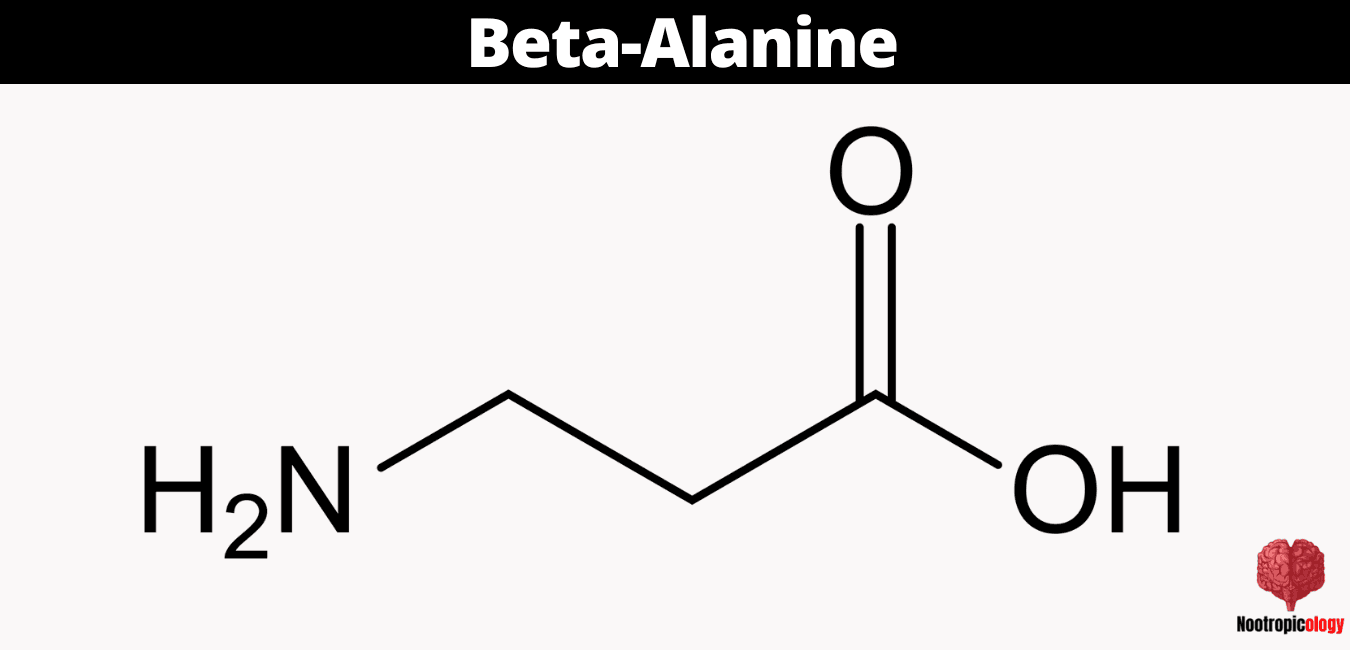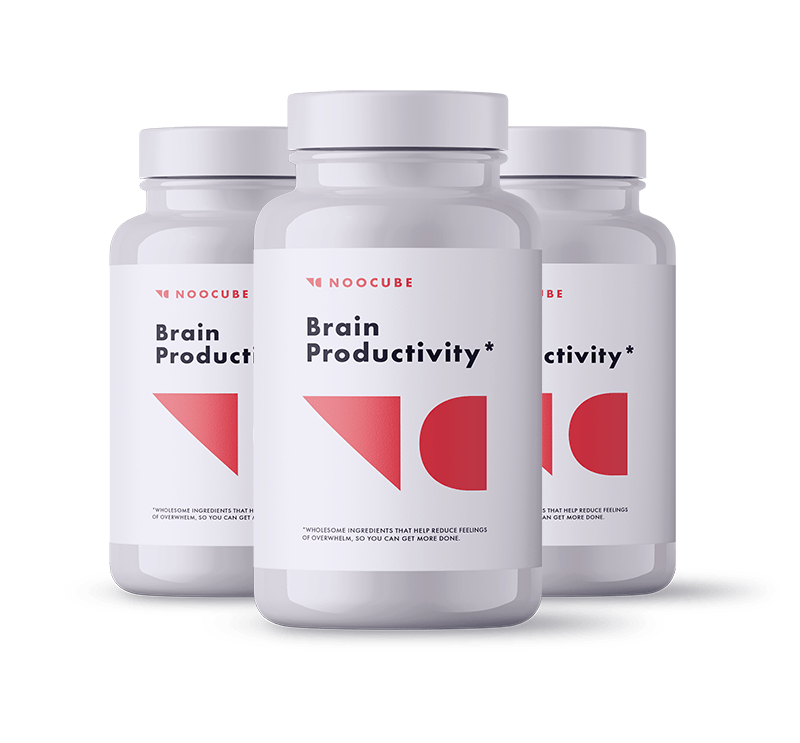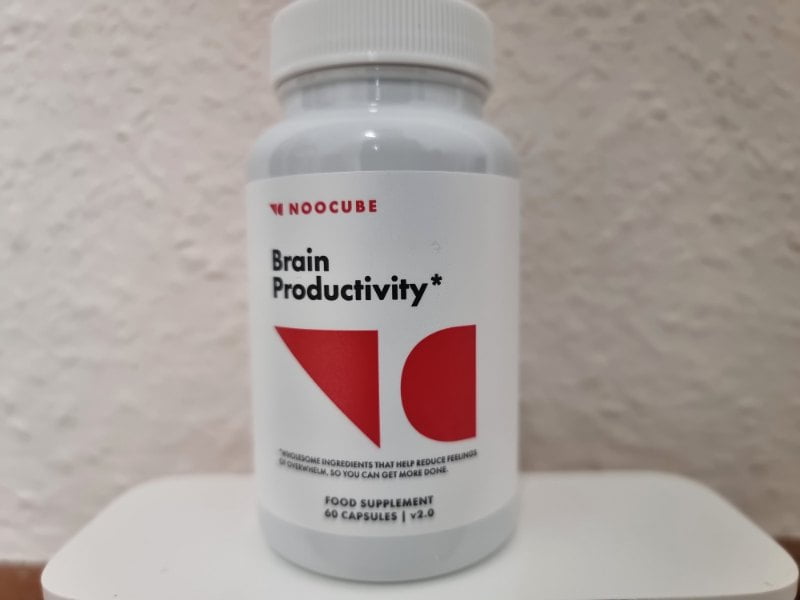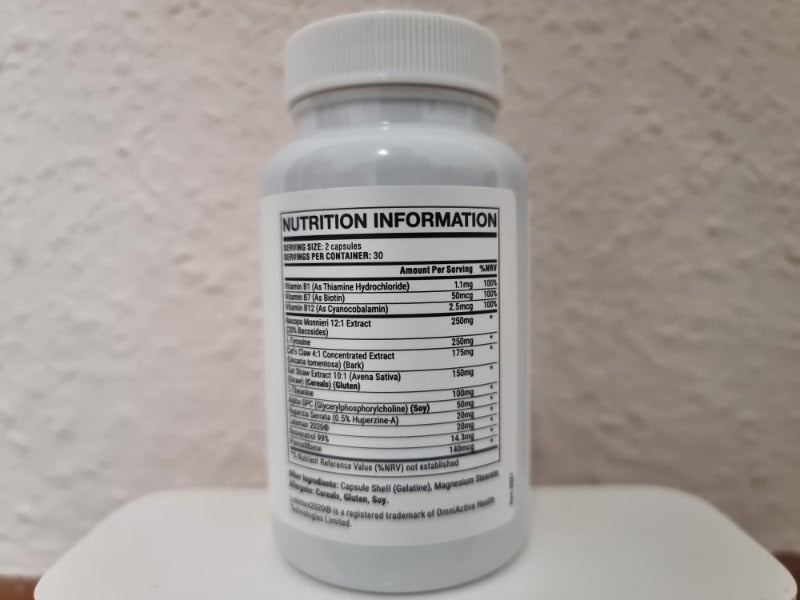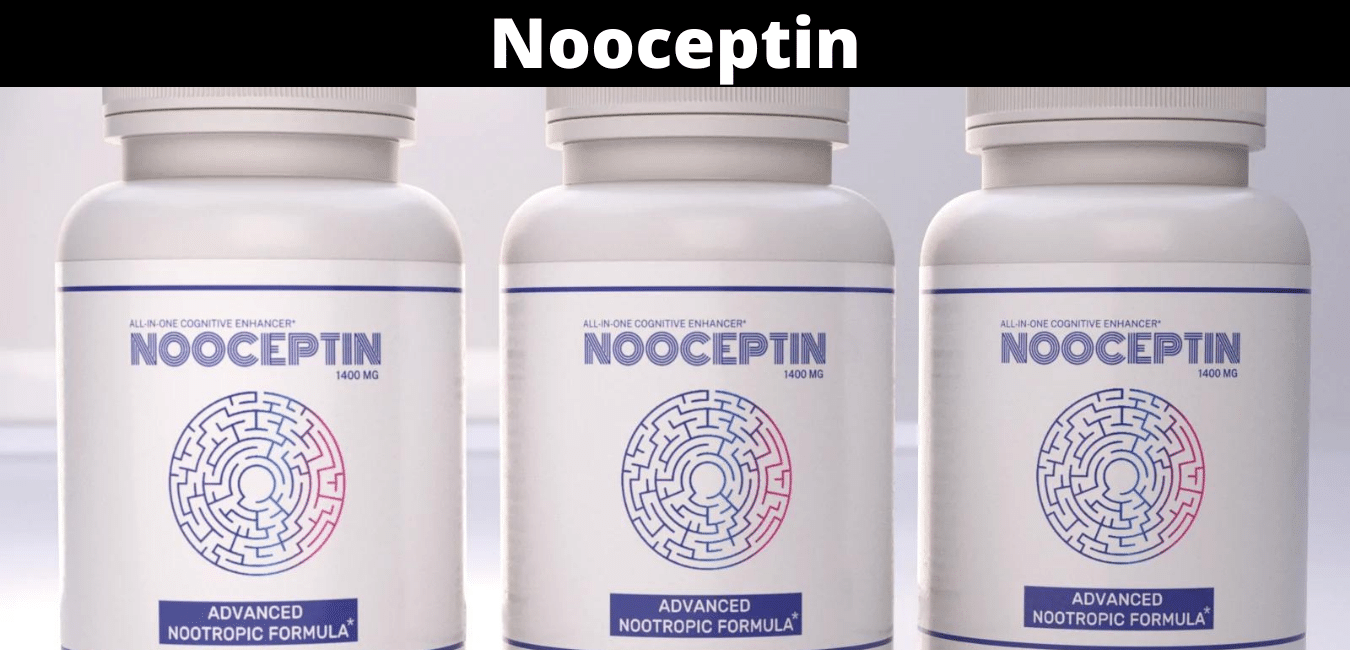
Nooceptin has emerged as a notable contender in the nootropic brain supplement market, acclaimed for its potential to enhance cognitive functions such as memory retention, focus, and overall mental well-being. Its formulation, rich in natural nootropic ingredients like Lion's Mane, Citicoline, and Bacopa Monnieri, is designed to support brain health and improve mental performance by increasing brain-derived neurotrophic factor (BDNF), crucial for learning and reducing cognitive decline risks.
However, despite the promising benefits, the long-term implications of Nooceptin and similar nootropic supplements remain a subject of caution. Potential users are advised to consider the minor and uncommon side effects associated with its ingredients, such as insomnia, headache, and nausea, and to consult healthcare professionals, especially when symptoms persist or in case of pre-existing health conditions.
Today, I'll take a closer look at Nooceptin, scrutinizing its cognitive enhancement claims, ingredient efficacy and potential side effects. This examination will assess the scientific backing of its formula and the veracity of its marketing assertions in the current world of nootropics.
What Is Nooceptin and How Does It Claim to Enhance Cognitive Function?
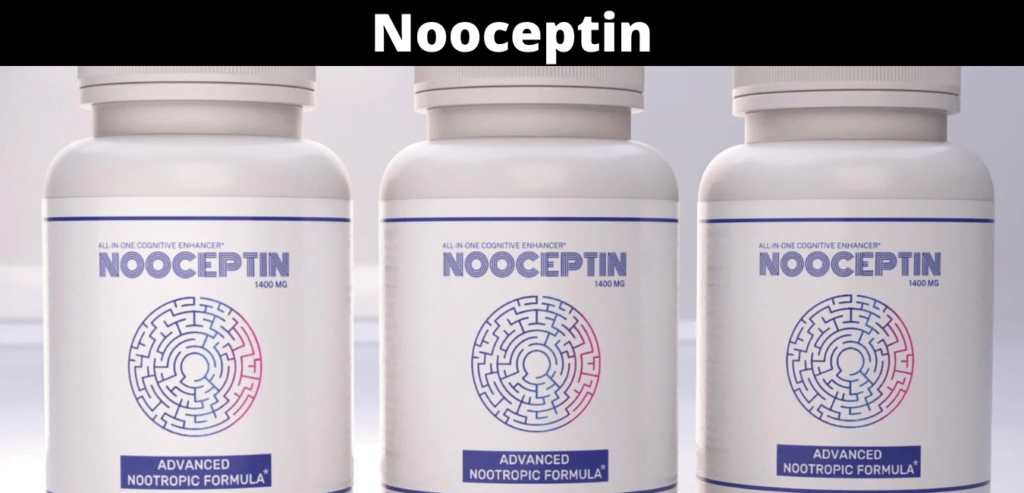
Nooceptin is a nootropic brain supplement that claims to enhance cognition by improving different aspects such as focus, memory, and mental clarity without the use of stimulants like caffeine. It purports to support brain health through natural ingredients that promote neurotransmitter production, neuron growth, and stress resistance. The supplement is designed to provide sustained mental energy, aiding in the reduction of brain fog and afternoon fatigue. Nooceptin's stimulant-free formula is intended to deliver cognitive benefits without the typical crash associated with caffeinated products.
What Are the Core Ingredients in Nooceptin and What Roles Do They Play?
Nooceptin includes ingredients such as Citicoline, Rhodiola Rosea, Bacopa Monnieri, L-Theanine, Ginkgo Biloba, Lion's Mane Mushroom, and Panax Ginseng. Citicoline is known for enhancing memory and brain function, Rhodiola Rosea for reducing fatigue, Bacopa Monnieri for improving memory formation, and L-Theanine for promoting relaxation without drowsiness. Ginkgo Biloba is reputed for its ability to increase blood flow to the brain, Lion's Mane for stimulating nerve growth factor, and Panax Ginseng for boosting brain function and mood.[1]
How Do These Ingredients Affect Brain Health and Cognitive Abilities
The ingredients in Nooceptin collectively support brain health and cognitive abilities by enhancing neuroplasticity, improving blood flow, and protecting neurons from oxidative stress. For instance, Citicoline increases phospholipid synthesis in the brain, essential for cognitive function,[2] while Bacopa Monnieri enhances dendritic length and branching,[3] crucial for brain communication. L-Theanine promotes alpha-wave production in the brain, associated with relaxed alertness.[4] These mechanisms contribute to improved memory, focus, and stress resilience.
Who Manufactures Nooceptin and Can Their Reputation Be Trusted?
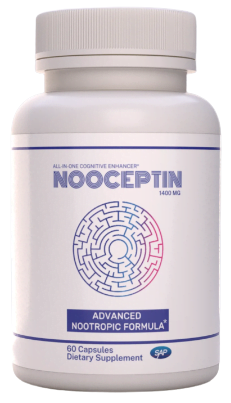
Nooceptin is produced by a company in the USA that specializes in nootropic supplements, focusing on natural, scientifically backed ingredients for cognitive enhancement. While specific details about the manufacturer's reputation require direct insights from consumer reviews and industry certifications, companies in this sector typically emphasize transparency, quality control, and research to build trust with consumers.
What Is the Company's Background and Its Impact on Nooceptin's Credibility?
Information about the company behind Nooceptin is scarce but from what I could find they have a background in health and wellness, with a focus on developing supplements that support cognitive function and mental health. The credibility of Nooceptin is enhanced by the use of ingredients with scientific backing for their efficacy in cognitive enhancement. The manufacturer's commitment to quality, safety, and efficacy, as demonstrated through adherence to manufacturing standards and plays a crucial role in establishing the product's reliability and effectiveness in the market.
Are There Clinical Studies or Research Validating Nooceptin's Claims?
Clinical studies and research on the individual ingredients within Nooceptin suggest potential cognitive benefits, including improved memory, focus, and overall mental well-being. However, comprehensive clinical trials specifically on Nooceptin as a complete formula are not detailed, making it crucial to rely on the evidence supporting its individual components. The efficacy of its ingredients, such as Bacopa Monnieri and Citicoline, in enhancing cognitive functions is well-documented.[5]
What Are the Proclaimed Benefits of Using Nooceptin?
Nooceptin is marketed as an all-in-one cognitive enhancer, claiming to improve memory, attention, focus, and reduce the risk of cognitive impairments. It aims to enhance neurochemistry and neuron health for better information recall and processing, protect brain cells, lower stress and anxiety, and increase productivity without relying on stimulants like caffeine.
How Effective Is Nooceptin in Enhancing Memory, Focus, and Overall Cognitive Abilities?
The effectiveness of Nooceptin in enhancing memory, focus, and overall cognitive abilities is supported by the known benefits of its ingredients. Users have reported positive outcomes such as increased concentration, motivation, and mental alertness, suggesting that Nooceptin can significantly improve cognitive performance and productivity. However, effectiveness can vary based on individual neurochemistry and lifestyle factors.
What Are the Potential Side Effects or Risks Associated with Nooceptin?
While Nooceptin is generally considered safe, with no severe side effects reported, potential risks may include individual intolerance or mild side effects such as sleep disturbances. It's recommended for certain groups, like pregnant women, nursing mothers, and those with chronic diseases, to avoid use due to the lack of comprehensive safety data.
What Are the Known Side Effects of Nooceptin's Ingredients?
The ingredients in Nooceptin, while effective, can cause side effects in some individuals. These may include insomnia, headache, nausea, and other minor symptoms. However, such side effects are uncommon and typically not serious, with the overall safety profile of Nooceptin's ingredients being favorable for most users.
Does Nooceptin Interact with Other Medications or Supplements?
Nooceptin may interact with certain medications, especially those that affect blood clotting, blood pressure, or diabetes. While interactions between nootropics and medications are generally rare, they can occur with specific drug classes such as antidepressants, anti-anxiety medications, bipolar medications, Parkinson’s medications, and blood thinners. It is recommended to consult with a healthcare provider before taking Nooceptin alongside any medications to avoid potential additive or antagonistic interactions.
My Personal Experience and Evaluation of Nooceptin
I recently bought Nooceptin to test it out myself for 30 days. Here's my personal experience with this nootropic.
What Were My Initial Impressions and Expectations of Nooceptin?
Initially, I was intrigued by Nooceptin's promise of cognitive enhancement without the reliance on stimulants. My expectations were shaped by its comparison to Vyvamind, anticipating a focus on long-term cognitive support rather than an immediate boost. The adaptogens in the formula, known for their calming effects, set my expectations for a supplement that would not only enhance cognitive function but also aid in stress management
How Did I Incorporate Nooceptin into My Daily Routine and Lifestyle?
I integrated Nooceptin into my daily routine by taking one capsule every morning, following the recommended dosage. This regimen was maintained for 30 days, followed by a 30-day break, to assess both the immediate and long-term effects of the supplement on my cognitive performance and stress levels. The adaptogens in Nooceptin, particularly Rhodiola Rosea, played a significant role in calming my mind, which was beneficial for my work-from-home lifestyle and responsibilities as a parent.
What Immediate and Long-Term Effects Did I Observe?
The effects of Nooceptin took a while to manifest, with noticeable improvements in focus, energy levels, and stress management emerging gradually. Similar to my experiences with Vyvamind, Nooceptin provided a sustained cognitive boost, but with the added benefit of reduced stress and anxiety, thanks to its adaptogenic components. Over the long term, I observed enhanced mental clarity, improved memory retention, and a more balanced mood, which contributed to increased productivity and an overall sense of well-being.
Did I Experience Any Side Effects or Adverse Reactions?
During my time taking Nooceptin, I experienced very mild nausea initially, which is a common reaction I have when introducing new supplements into my routine. However, this side effect was transient and did not persist beyond the first few days of use. No other adverse reactions were noted, aligning with the supplement's profile as being composed of natural, well-tolerated ingredients. The absence of significant side effects, combined with the positive cognitive and stress-relieving effects, made my experience with Nooceptin largely positive.
How Does My Experience Align with Nooceptin's Claims and User Testimonials?
My evaluation of Nooceptin aligns closely with its claims and the positive feedback found in user testimonials on platforms like Reddit. Users often highlight Nooceptin's effectiveness in enhancing focus, memory, and cognitive performance, mirroring my observations of improved mental clarity and stress management. The consensus among real users suggests that Nooceptin delivers on its promise of cognitive enhancement without the adverse effects commonly associated with stimulants.
How Do Real Users Rate Nooceptin's Impact on Cognitive Performance?
Real users on Reddit rate Nooceptin highly for its impact on cognitive performance, particularly praising its ability to improve concentration, memory recall, and mental energy. Many users report experiencing noticeable benefits in their professional and academic endeavors, finding Nooceptin to be a valuable tool for achieving a competitive edge and managing stress.
What Common Experiences Are Shared in Customer Testimonials?
Common experiences shared in customer testimonials include significant improvements in focus, memory retention, and overall mental well-being. Users frequently mention the absence of jitteriness or crashes, a common drawback of caffeine-based products, and appreciate Nooceptin's smooth, sustained energy boost. Additionally, many testimonials highlight the supplement's role in enhancing productivity and cognitive agility in high-stress environments. According to Nooceptin's official website, a testimonial from Dr. Olivia Levine, a PhD Neuroscientist, states the following:
"Overall, the seven active ingredients in Nooceptin show promising effects that may enhance cognitive function and reduce stress in combination with a healthy lifestyle."
How Consistent Are User Experiences with Nooceptin's Advertised Claims?
User experiences with Nooceptin are largely consistent with the product's advertised claims. Testimonials and reviews often reflect the supplement's effectiveness in enhancing cognitive functions, such as memory and focus, and its ability to support mental health by reducing anxiety and stress. This consistency between user experiences and Nooceptin's marketing suggests a credible and reliable product.
What Is the Recommended Usage of Nooceptin for Optimal Cognitive Benefits?
The recommended usage of Nooceptin for optimal cognitive benefits, as suggested by the manufacturer and echoed by user experiences, involves taking 1-3 capsules daily, preferably on an empty stomach with a light meal in the morning. Starting with a lower dose and gradually increasing to the full dosage can help assess tolerance and effectiveness. Consistent use, coupled with a healthy lifestyle, is advised to maximize cognitive enhancements and achieve the best results.
What Dosage, Frequency, and Timing Are Recommended?
The recommended dosage for Nooceptin typically aligns with the dosages used in clinical studies for its key ingredients. For optimal cognitive benefits, users are often advised to follow the manufacturer's instructions, which suggest taking a specific number of capsules daily (1-3), often in the morning with a meal to enhance absorption and reduce the risk of gastrointestinal discomfort. Consistency in frequency and timing is emphasized to maintain steady levels of the active ingredients in the body.
Are There Any Best Practices or Guidelines for Enhancing Its Effects?
Best practices for enhancing the effects of Nooceptin include maintaining a healthy lifestyle with adequate sleep, a balanced diet, and regular exercise. Hydration and minimizing the use of substances that can impair cognitive function, such as alcohol, can also play a crucial role. Some users find that combining Nooceptin with a routine that includes mental exercises or meditation may amplify its cognitive benefits.
What Does Scientific Research Say About Nooceptin's Ingredients and Efficacy?
Over the past years, scientific research on the ingredients found in Nooceptin, such as Bacopa Monnieri, Citicoline, and Lion's Mane Mushroom, has supported their efficacy in enhancing cognitive functions. Studies have shown these ingredients can improve memory, focus, and neuroplasticity.[6] However, it's important to note that while individual ingredients have been studied, comprehensive research on the Nooceptin formula as a whole is limited.
Is There a Consensus in the Scientific Community on Nooceptin's Effectiveness?
While there is a general consensus in the scientific community regarding the potential cognitive benefits of Nooceptin's individual ingredients, the effectiveness of the combined formula remains less explored. The consensus often emphasizes the need for more extensive, long-term studies to fully understand the synergistic effects of combining these nootropic substances.
How Does Nooceptin Compare to Other Nootropics in the Market?
Nooceptin is often compared favorably to other nootropics in the market such as Vyvamind and Mind Lab Pro due to its comprehensive blend of scientifically backed ingredients. Its stimulant-free formula distinguishes it from products relying on caffeine or other stimulants for a temporary cognitive boost. However, like all nootropic supplements, individual experiences can vary, and what works best can depend on personal health, lifestyle, and specific cognitive goals.
What Unique Features or Ingredients Distinguish Nooceptin?
Nooceptin distinguishes itself with a unique blend of ingredients, including Citicoline, L-Theanine, Bacopa Monnieri, and Lion's Mane Extract, each known for their cognitive benefits. A standout feature is its inclusion of Lion's Mane Extract, which is not as commonly found in other nootropics and is linked to nerve growth factor (NGF) production, crucial for neuron health and cognitive function. This combination of ingredients is designed to work synergistically, enhancing each other's effects to improve cognitive performance more effectively than if taken individually. Here's a breakdown of the exact amount you get:
- Citicoline (as cytidine 5'-diphosphocoline, sodium): The specific amount is not provided on their website. However, oral dosages of citicoline in clinical settings have ranged from 250 to 2,000 mg daily.
- Rhodiola Rosea Extract (root): 150mg, standardized to 3% rosavins & 1% salidroside.
- Bacopa monnieri Extract (whole plant): 150mg, standardized to 40% bacosides.[7]
- L-Theanine (L-γ-glutamylethylamide): 200mg.
- Ginkgo biloba Extract (leaf): 100mg, standardized to 24% ginkgo flavone glycosides & 6% terpene lactones.
- Lion's Mane Extract (Hericium erinaceus) (fruiting body): 400mg, standardized to 30% polysaccharides.
- Panax ginseng Extract (root): 200mg.
Are There Competing Products That Offer Better Results or Value?
While Nooceptin is highly regarded for its comprehensive formula, there are competing products in the market that users may find offer better results or value depending on their specific needs. For instance, some users might prefer nootropics that include a stronger emphasis on immediate stimulant effects as found in Vyvamind, or those with a lower price point. However, Nooceptin's balanced approach to cognitive enhancement without reliance on stimulants and its focus on long-term brain health benefits positions it as a valuable option for many
What Are the Limitations or Criticisms of Nooceptin?
One of the main criticisms of Nooceptin is its higher price point compared to some other nootropic blends, which may deter budget-conscious consumers. Additionally, while its ingredients are backed by scientific research, the specific formulation of Nooceptin itself lacks extensive independent clinical trials to validate its combined efficacy, leaving some users to rely on anecdotal evidence and individual ingredient studies.
Are There Any Drug Interactions or Contraindications?
Nooceptin, like many nootropic supplements, may interact with certain medications, particularly those affecting neurotransmitter levels, blood clotting, and blood pressure. Users taking prescription medications or those with pre-existing health conditions are advised to consult with a healthcare provider before starting Nooceptin to avoid potential adverse drug interactions. The supplement's natural ingredients are generally considered safe, but the possibility of interactions underscores the importance of personalized medical advice.
What Ethical Considerations Surround the Use of Nooceptin?
The use of Nooceptin and similar cognitive enhancers raises ethical considerations regarding fairness, consent, and the potential for coercion in competitive environments like academics or the workplace. There is an ongoing debate about whether such supplements provide an unfair advantage or if they should be accessible to all to level the playing field. Additionally, the marketing of nootropics must be scrutinized to ensure claims are not misleading and that consumers are fully informed about the potential effects and limitations of the product. Ethical concerns also extend to the sourcing of ingredients, with expectations that companies engage in sustainable and socially responsible practices.
How Does Nooceptin's Pricing Compare to Similar Products?
Nooceptin's pricing structure offers a range of options to suit different budgets and usage patterns. A single month's supply is priced at $69, with savings available for larger purchases, such as the 2-month supply at $138 and the Cyber Monday Deal offering a 3-month supply for $197. These prices position Nooceptin competitively within the nootropic market, especially considering the discounts for bulk purchases and the quality of the ingredients.
Does Nooceptin Offer Financial Incentives Like Discounts or a Money-Back Guarantee?
Nooceptin provides financial incentives through multibuy savings, allowing users to save more with larger purchases. For example, buying a 3-month supply saves $28 compared to purchasing three individual bottles. However, there is no mention of a money-back guarantee, which may affect the decision-making of potential customers looking for a risk-free trial.
What Are Common Consumer Concerns and Questions About Nooceptin?
From my market research, the common consumer concerns about Nooceptin include the potential for side effects, such as insomnia and digestive issues, although these are considered minor and uncommon. The moderate dosage of Nooceptin is designed to minimize risks, but individual sensitivities can vary, leading to mild symptoms in some users. Questions often revolve around the efficacy of Nooceptin in enhancing mental clarity, memory function, stress management, and sustained energy levels, all of which are key claims of the product. Consumers are also interested in the scientific backing of the ingredients and the overall safety of the supplement for long-term use.
What Are the Guidelines for Combining Nooceptin with Other Supplements?
Nooceptin is considered safe to stack with other supplements, as its all-natural ingredients minimize the risk of interactions. However, it's recommended to consult with a healthcare professional before combining Nooceptin with other supplements, especially if they contain similar active ingredients or if there's a concern about over-supplementation. The manufacturer suggests taking Nooceptin with a glass of water shortly after breakfast, which can easily integrate into most supplement routines without causing adverse effects
Who Should Avoid Using Nooceptin and Why?
Nooceptin is designed for a wide audience seeking cognitive enhancement, including students, professionals, gamers, entrepreneurs, and seniors. However, individuals with pre-existing medical conditions, those on prescription medications, pregnant or nursing women, and anyone under 18 should avoid using Nooceptin. This caution is due to the potential for unknown interactions with medications and the lack of research on the effects of Nooceptin's ingredients in these specific populations.
Where Can Nooceptin Be Purchased?
Nooceptin can be purchased directly from its official website, which is the most recommended channel to ensure authenticity and to receive the actual and real formula. The official site offers various purchasing options, including single and multiple-bottle packages, with free and fast shipping.
Are There Authorized Retailers or Online Platforms for Nooceptin?
In addition to the official website, Nooceptin is available on Amazon, where various sellers offer the product, often with the convenience of fast and tracked shipping. However, buyers should exercise caution and ideally purchase from reputable sellers to avoid counterfeit products.
What Should Buyers Be Aware of When Purchasing Nooceptin to Ensure Authenticity?
Buyers should be aware of the potential for counterfeit products when not purchasing directly from the official website. To ensure authenticity, it is recommended to buy Nooceptin from the official site or authorized retailers. Checking for a secure payment gateway and clear return policies can also help verify the legitimacy of the seller.
Based on the Review, Is Nooceptin Recommended for Cognitive Enhancement?
Based on this Nooceptin review, Nooceptin is recommended for cognitive enhancement due to its blend of natural ingredients, positive user testimonials, and my own personal experience. It is manufactured in an FDA-approved and GMP-certified facility, ensuring quality and safety standards. While individual results may vary, the product is generally considered effective for improving brain function and overall well-being. I highly recommend giving Nooceptin a try.
- Baba, Yoshitake et al. “Effects of l-Theanine on Cognitive Function in Middle-Aged and Older Subjects: A Randomized Placebo-Controlled Study.” Journal of medicinal food vol. 24,4 (2021): 333-341. doi:10.1089/jmf.2020.4803
- Adibhatla, R M et al. “Effects of citicoline on phospholipid and glutathione levels in transient cerebral ischemia.” Stroke vol. 32,10 (2001): 2376-81. doi:10.1161/hs1001.096010
- McPhee, Grace M et al. “The Neurocognitive Effects of Bacopa monnieri and Cognitive Training on Markers of Brain Microstructure in Healthy Older Adults.” Frontiers in aging neuroscience vol. 13 638109. 22 Feb. 2021, doi:10.3389/fnagi.2021.638109
- Evans, Malkanthi et al. “A Randomized, Triple-Blind, Placebo-Controlled, Crossover Study to Investigate the Efficacy of a Single Dose of AlphaWave® L-Theanine on Stress in a Healthy Adult Population.” Neurology and therapy vol. 10,2 (2021): 1061-1078. doi:10.1007/s40120-021-00284-x
- Malík, Matěj, and Pavel Tlustoš. “Nootropics as Cognitive Enhancers: Types, Dosage and Side Effects of Smart Drugs.” Nutrients vol. 14,16 3367. 17 Aug. 2022, doi:10.3390/nu14163367
- Lai, Puei-Lene et al. “Neurotrophic properties of the Lion's mane medicinal mushroom, Hericium erinaceus (Higher Basidiomycetes) from Malaysia.” International journal of medicinal mushrooms vol. 15,6 (2013): 539-54. doi:10.1615/intjmedmushr.v15.i6.30
- Kumar, Navneet et al. “Efficacy of Standardized Extract of Bacopa monnieri (Bacognize®) on Cognitive Functions of Medical Students: A Six-Week, Randomized Placebo-Controlled Trial.” Evidence-based complementary and alternative medicine : eCAM vol. 2016 (2016): 4103423. doi:10.1155/2016/4103423
source https://nootropicology.com/nooceptin/
